5 Types of Ticks in Maryland (With Pictures)
-
Pete Ortiz
- Last updated:
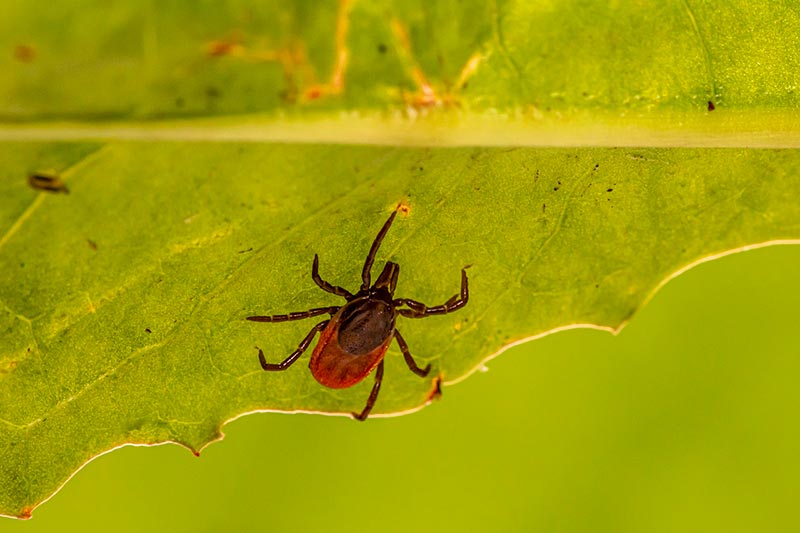
Between 2004 and 2016, tick-borne illnesses doubled in Maryland. Marylanders are at the highest risk of tick-borne diseases from spring to fall when ticks are most active. However, these ticks pose a threat throughout the year as long as the temperature is above freezing.
There are 90 species of ticks in the United States, but Marylanders need to watch out for five types that are present in the state. These ticks present a threat to humans and pets. They are mostly found outdoors but can be brought indoors by animal hosts.
With the tick species in Maryland notorious for spreading life-threatening diseases, it’s important to learn about them and how to deal with bites. Read on to find out about the types of ticks in Maryland, their preferred hosts, and the diseases they spread.
The 5 Types of Ticks in Maryland
1. American Dog Ticks
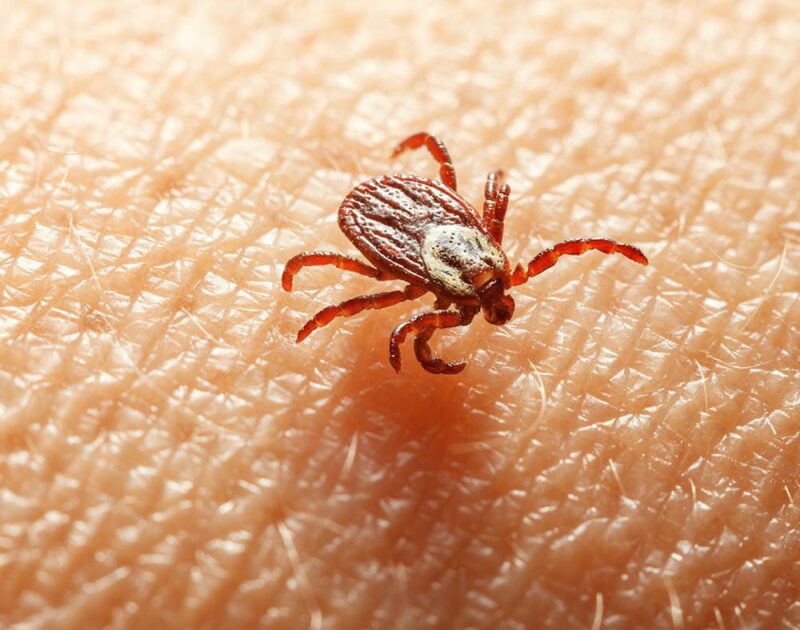
- Hard exterior shield
- Brown with whitish-to-gray markings
- 5mm unengorged, 15 mm engorged
American dog ticks are only found in North America. They thrive in areas with no or little tree cover and can be found along trails, sidewalks, and grassy fields.
They are 3-host ticks, meaning they have three hosts throughout their life cycle. As larvae and nymphs, they feed on rodents. Adults prefer bigger hosts, including dogs, cats, and humans.
Diseases Spread
American dog ticks spread Rocky Mountain spotted fever (RMSF), tularemia, and can cause tick paralysis. They are the primary vectors of RMSF, while they transmit tularemia from infected rodents and other small animals.
2. Black-Legged Ticks (Deer Ticks)
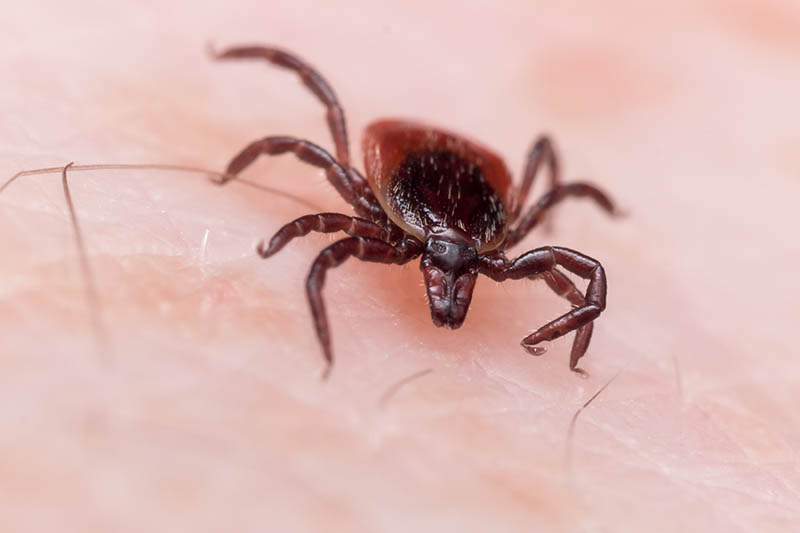
- Round, reddish brown or black scutum
- Smallest ticks in the United States
Black-legged ticks are also known as deer ticks because white-tailed deer are their primary hosts. They are prevalent in areas where deer dwell, and are hence rampant in deciduous forests across Maryland.
Deer ticks are the main transmitter of Borrelia burgdorferi, which causes Lyme disease. Maryland’s high deer population means residents are at a higher risk of Lyme disease compared to other states.
Adult black-legged ticks are active throughout the year, feeding on deer during the winter. Larvae and nymphs are active during the summer and fall.
Diseases Spread
Deer ticks transmit pathogens causing Lyme disease, ehrlichiosis, babesiosis, anaplasmosis, and Powassan virus disease.
3. Brown Dog Ticks
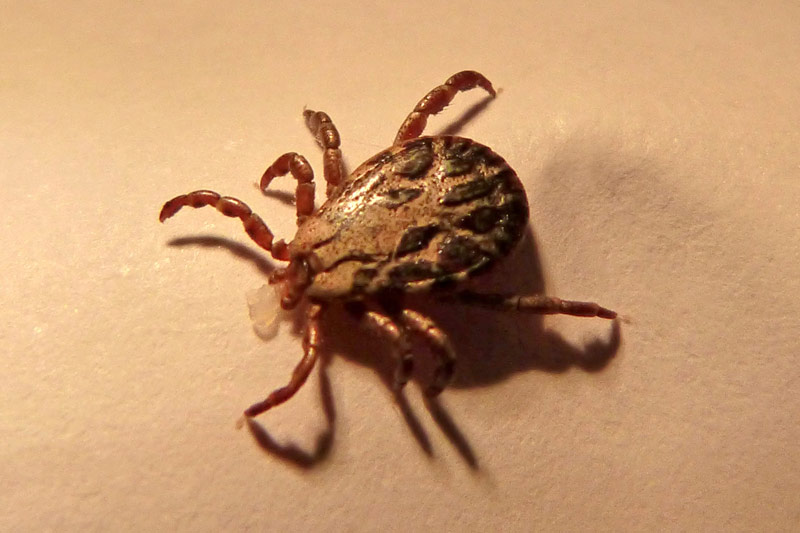
- Red-brown in color, blue-gray after feeding
- ⅛ inch long unfed, ½ inch long fed (adult female)
- Brown scutum with no markings
As their name suggests, these ticks love feeding on dogs. This means they are commonly found in homes, even though their natural habitats are wooded and grassy areas.
Brown dog ticks are active throughout the year in all three life stages. When infesting dogs, adults hide between the toes or attach to the ears. Larvae and nymphs hide in the back hair. Other than dogs, these ticks can also bite humans or other mammals.
Diseases Spread
Brown dog ticks spread Rocky Mountain spotted fever in humans and canine babesiosis and canine ehrlichiosis in dogs.
Early symptoms of Rocky Mountain fever include headache, fever, rash, and nausea. The disease can be deadly when not treated early. Canine ehrlichiosis attacks white blood cells in dogs, while babesiosis attacks the red blood cells.
4. Lone Star Ticks
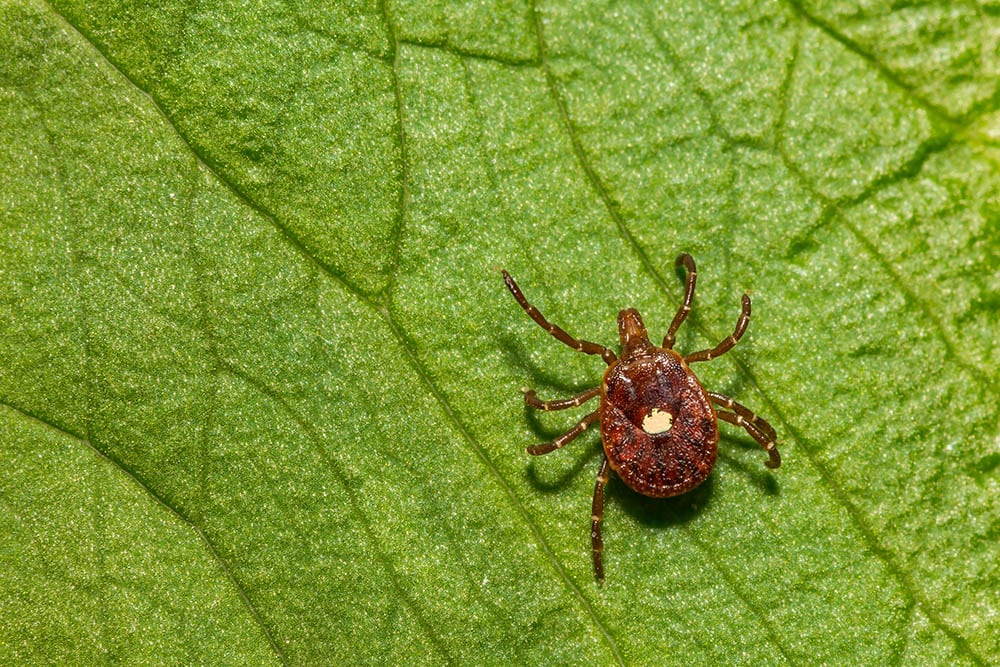
- Reddish brown in color
- Diamond-shaped scutum
- Star mark on their backs
These ticks are named for the single star mark found on the backs of the females. Males have several spots along their backs, whitish to silvery in color.
Lone star ticks live in dense woodlands. They are also common near animal resting areas. They are active between April and late September.
These ticks aggressively feed on humans in all three stages of life. They also feed on pets like dogs and cats. Lone star ticks don’t spread Lyme disease, but they transmit a host of other serious tick-borne diseases.
Diseases Spread
Nymph and adult lone star ticks can spread germs causing tularemia, Heartland virus disease, human ehrlichiosis, Bourbon virus disease, Alpha-gal syndrome, and Southern tick-associated rash illness (STARI).
Lone star tick saliva is irritating and can cause redness and discomfort in the bite area. However, this is not a sign of infection. Instead, symptoms such as a headache, fever, muscle pains, and a rash within 30 days of the bite could indicate an infection.
5. Gulf Coast Ticks

- Scutum covers the entire back in males, and the upper back in females
- Females have three posterior stripes, males have multiple silvery white stripes
The Gulf Coast ticks are native to the southeastern Gulf Coast states and are not very common in Maryland. However, their range is expanding north and their presence is growing in the state.
Gulf Coast ticks inhabit wooded areas and grassland prairies. They are 3-host ticks, moving from small rodents and birds as larvae to dogs as nymphs. As adults, they feed on livestock, pets, and humans. They commonly attack their hosts’ ears and can feed for up to ten days.
Diseases Spread
Gulf Coast ticks transmit Rickettsia parkeri Rickettsiosis in humans. This illness has similar symptoms as RMSF, including headache, rash, and fever. It is however less severe than Rocky Mountain spotted fever.
In livestock and pets, Gulf Coast ticks can spread American canine hepatozoonosis, Leptospirosis, and heartwater disease. These ticks can also cause tick paralysis in humans and dogs.
How to Remove and Dispose of a Tick
Knowing how to remove a tick properly prevents further injury to you or your pet. Follow these steps for safe tick removal:
- Use a pair of tweezers to grab the tick’s head as close to the skin as possible. Avoid squeezing the body, as this might cause it to vomit blood and saliva into your skin, increasing your risk of infection.
- Apply even pressure and pull the tick upward steadily. Avoid twisting as this might cause the tick’s mouth parts to break and remain in your skin. If mouth parts remain in the skin, you’ll still heal, but constantly check for infection.
- Clean the bite area with rubbing alcohol, iodine, or hydrogen peroxide. You can also use soap and warm water.
Once removed, dispose of the tick properly to ensure it doesn’t reattach itself to family members or pets.
- Put it in alcohol
- Seal in a bag or container
- Wrap in tape
- Flush down the toilet
After getting rid of the tick, be on the lookout for symptoms such as fever and a rash for the coming weeks. In pets, watch out for lethargy, weight loss, swelling in limbs, and diarrhea. If any symptoms appear, see a doctor or veterinarian right away.
Final Thoughts
Despite their small sizes, ticks carry pathogens that affect humans, pets, and livestock. Tick species found in Maryland are especially dangerous as they transmit most of the deadly tick-borne diseases found in the United States.
Precautionary measures such as keeping your house rodent-free, checking your pets for ticks regularly, and using insecticides in your yard can keep you safe. If you’ve been to a tick-prone area, treat your clothes with a product containing at least 0.5% permethrin.
Featured Image Credit: Erik_Karits, Pixabay
Contents



